Evolution of weapons: Exotic cartridges
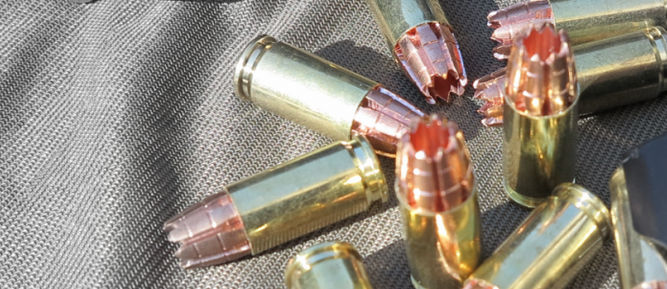
Gallery of experimental ammunition. From bezgylzovyh and arrow-like, to multi-bullet and underwater.
The unitary cartridge invented at the beginning of the 19th century marked the beginning of the revolution in the arms business. Since then, its design has not undergone radical changes, but many attempts have been made to come up with something original, something more perfect.
Bezgilovye and jet.
Cartridge with a departing sleeve.
The 9mm AUPO cartridge was designed and tested in the first half of the 1980s by the Italian designer Bruno Civolani. Specially for this ammunition, Benelli Armi designed the Benelli CB-M2 pistol.
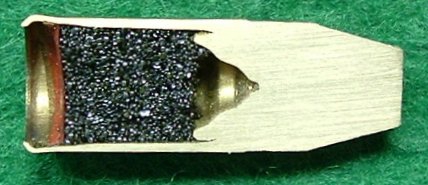
The 9mm AUPO cartridge consisted of an all-metal head and a hollow, thin-walled rear part shaped like a cylinder.

The scheme of work of the impact mechanism and the cartridge device of the Benelli CB-M2 submachine gun.
The back of the cartridge, made in the form of a "glass", served as a liner, inside it lay a propellant powder charge and a charge of a flammable substance (a capsule charge) located in a circle. The open back part of the sleeve was closed by a burning diaphragm, which protected the charge from spillage and moisture during storage.
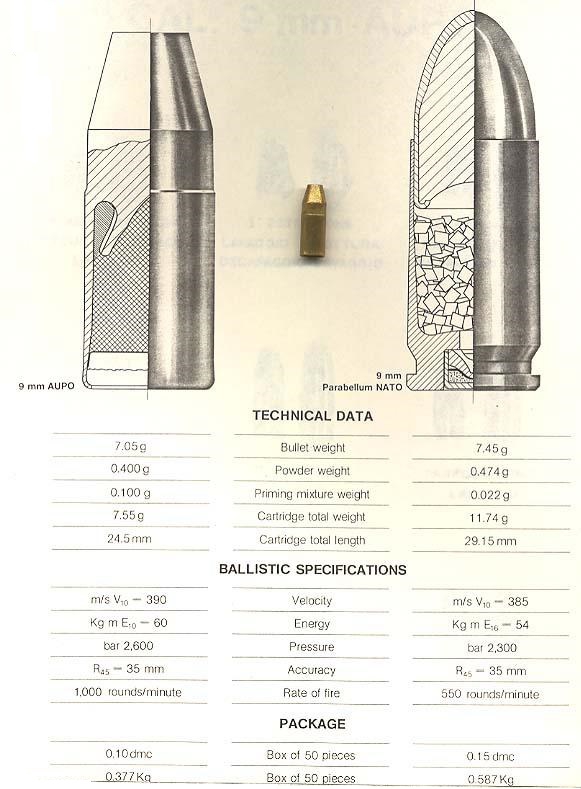
Inflammation of the capsule charge was carried out by striking the striker along the wall of the cartridge in the region of the placement of the capsule composition, while the wall of the sleeve was slightly deformed, but did not penetrate right through. The charge of gunpowder completely burned in the bore of the barrel, while the bullet flew entirely together with the "sleeve".

Benelli CB-M2

Scheme from the 1981 patent, illustrating the operation of the automation of the Benelli CB-M2 submachine gun.
In case of a misfire, the edges of the "glass" of this cartridge are slightly bent inside. For this protrusion, the hook of the extractor clings. If the ignition succeeds, the "sleeve" under the pressure of the gases opens up to the walls of the chamber, thus releasing the extractor hook.
Cartridges with compressed charge.
In the early 60s of the last century, the Ministry of Defense of Germany funded a research program to develop and study bezgulzovyh ammunition of intermediate calibers. Experimental design work was carried out by Dynamit Nobel.
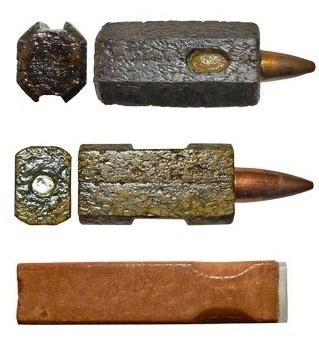
From the top down: the experimental 4.3x21 DAG and 4.7x21 DE11, the final 4.73x33 HK.
Designed by Dynamit Nobel, the ammunition originally had a caliber of 4.3 mm, the bullet being pressed into the front of the powder-coated powder gun, to the back of which a combustible primer was glued. This cartridge had a significant drawback - with intensive shooting, the powder charges in the chamber were self-igniting.
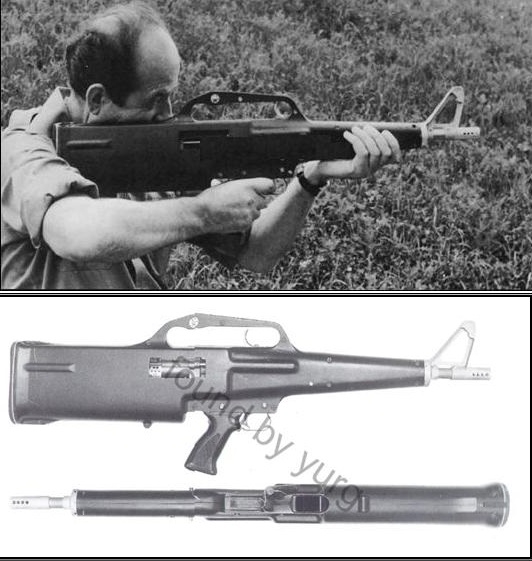
Mauser G11 - an experimental sample for the cartridge 4.7x21 DE11, a competitor of the same name rifle Heckler & Koch.
In 1975, the design of the cartridge was recycled, and the caliber was increased from 4.3 mm to 4.75 mm. In December 1978, when a new high-temperature HITP powder was developed, consisting of an octogen, cellulose with impurities and viscose filaments to increase the mechanical strength of the propellant charge.
Adoption of the NATO 5.56x45 cartridge by the NATO bloc meant the loss of the ability to standardize a no-cartridge in the foreseeable future, and in March 1979 the government of the Federal Republic of Germany stopped financing the development of the G11.
Dynamit Nobel and Heckler & Koch continued to develop the G11 and the deadly munitions at their own expense.
In 1981, comparative tests were carried out, during which it was found that a 4.7? 34 mm caliber cartridge, having the shape of a parallelepiped and a telescoping configuration, has several advantages over previously developed samples. By 1983, the final decision was made to switch to a new 4.7-33 mm caliber cartridge.
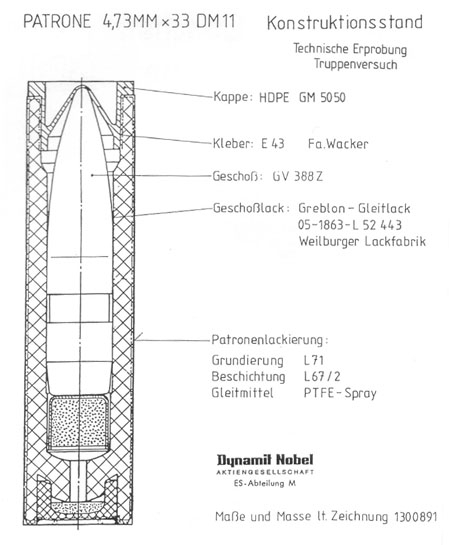
For him, a new nitramine based powder with a high moisture resistance and heat resistance was developed. The capsule composition consisted of a copper cup, providing chemical isolation of the charge. Between the capsule and the bullet the accelerating charge was placed from the quick-gathering gunpowder. Reduction of leakage of powder gases into the bore of the barrel before the bullet was provided with a plastic cover and a high density of the propellant charge. To increase the heat resistance of the propellant charge, its surface was pyrolyzed - heat treated without access to oxygen. The bullet was coated with a solid lubricant based on molybdenum. The development of the final design of the cartridge DM11 was completed by 1987.
In the 80's, the G11 rifle (read more about it here) and the cartridgeless cartridges were tested in the USA (in the framework of the Advanced Combat Rifle research program) and Switzerland. But in both cases, the military stopped the choice of rifles under the ammunition of the traditional design. In 1988, the G11 rifle entered military tests in the FRG, which took place before 1990. Tests of various modifications of the rifle took place in parts of mountain riflemen and airborne troops. In 1990, the rifle successfully passed the tests and in September of the same year the signing of a contract for the supply of 200,000 pieces of rifles to the troops was being prepared. But the contract was not approved in view of the political and economic changes in the country that was on the verge of unification with the GDR, after which the development of weapons and ammunition was stopped.
Another similar cartridge was also developed in the US by AAI Corporation in the early 1980s, for the Advanced Infantry Weapon System (AIWS), a search-based replacement for the M-16 rifle.

Several modifications were developed. The main variant was a version with a 4.3 mm sub-caliber bullet with a lead core in a drop-down segment tray.
The propellant charge had a cylindrical shape and consisted of compressed tube gunpowder of short cutting mixed with collodion. A bullet was placed in front of the charge, and in the bottom of the charge there was a burning primer, covered with a rubberized protective pad. The development of the cartridge was stopped because the AAI Corporation rifle did not pass the competitive selection and showed unsatisfactory results in the tests for the reliability and accuracy of the fight.
| Diameter of bullet: |
4.3 mm |
| Length of the cartridge: |
41.44 g |
| Length of propellant charge: |
31.83 mm |
| The diameter of the gunpowder: |
9.15 mm |
| Bullet weight: |
1.8 mm |
| Cartridge Weight: |
4.28 g |
| Initial speed of the bullet: |
? |
Jet Gyrojet
Perhaps the best-known dead-end circuit diagram is a reactive cartridge to the American pistol MBA Gyrojet.
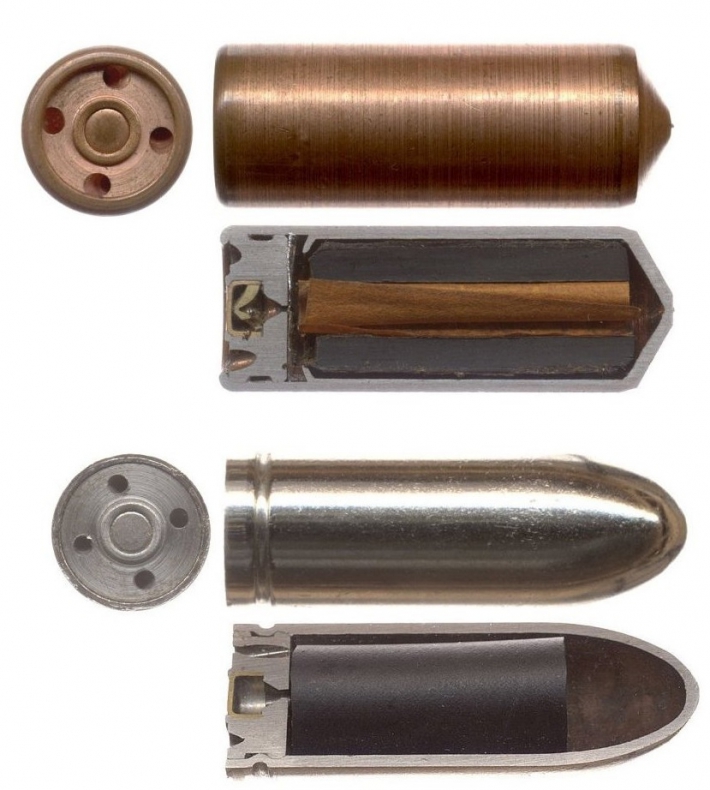
Gyrojet reactive bullets (13-50 mm) made of stainless steel had a low initial speed and were stabilized only by rotation due to the deviation of a part of the powder gases in the radial plane, but the shot was practically silent, and at a range of 55 m the energy of the accelerated bullet was almost twice Exceeded the energy of the bullet fired from the Colt M1911 pistol.
Underwater active-reactive cartridge of 7.62-mm caliber
In 1967, the Soviet Navy ordered the TsNIITOCHMASh to develop a complex of underwater weapons for combat swimmers.
The development of an underwater pistol and ammunition for it was launched in February 1968 by DI Shiryaev. Together with Matveykin SI - Engineer in the field of development of solid fuel engines. The project was based on open patent documentation on the Gyrojet pistol.
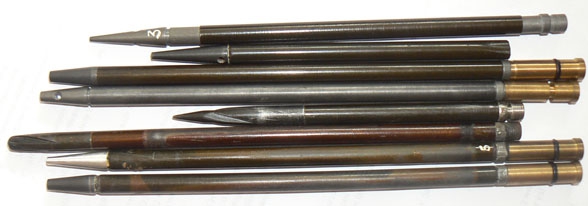
The cartridge consisted of a long steel tube with a sharp and heavy tip. In the tube was placed solid-fuel pellet. From the bottom, the tube was covered by a jet engine nozzle and a steel pallet. On the barrel sockets, the rocket was guided by a tin lead band, providing the initial twist of the bullet. The rocket was fastened in a brass case with an explosive charge and a "Zhevello" capsule.
The first samples of the pistol and ammunition were ready by July 1968 and tested in Feodosia.
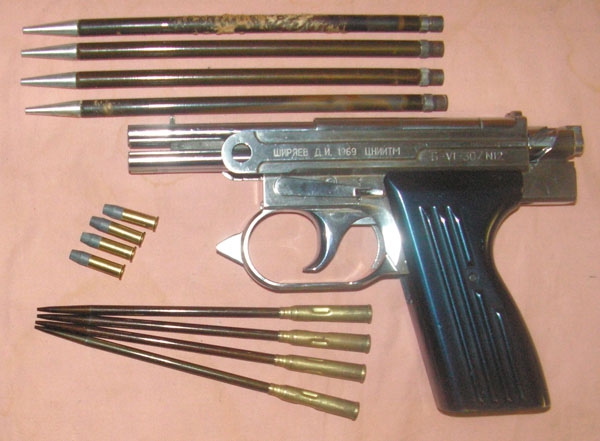
Pistol D.I. Shiryaev and various ammunition to him.
According to the test results, it was decided to abandon the concept of a reactive bullet and switch to creating an ammunition, the stability of its movement in the water would be ensured by the effect of cavitation.

Active-reactive cartridge in dismantling.
The developers abandoned the ignition system of the gunpowder through the throttle hole in the engine nozzle. Instead, a system for igniting a march-shaped gunpowder from the front of the bullet was developed with the aid of an inertially settling capsule and an ignition charge consisting of a charge of black powder DRP-2 and a pyrotechnic tablet of B6M. The twisting of the first non-coveting active-rocket missiles on the trajectory was ensured by longitudinal filaments forming a screw on the head fairing of the bullet. In cavitating missiles, the spout was made of steel or duralumin, had a sharp conical shape or a truncated cone shape. To accelerate the formation of a gas bubble around the rocket, a portion of the propellant gases was diverted from the gunpowder through the holes in the tip of the rocket.

In the end, the active-reactive munition was worked out and provided stable operation at depths of up to 17 meters, at a speed of 200 m / s, ensuring the penetration of four-inch pine boards at a distance of 25 meters. At a depth of 20 meters, the missiles quickly lost stability. This problem could be solved by increasing the initial velocity of the bullet by 20 m / s, but by 1970 the work on the active-reactive cartridges for the underwater pistol was curtailed, and the model of the underwater pistol developed by Vladimir Simonov was adopted.
| Diameter of bullet: |
7.91 mm |
| Cartridge Weight: |
32.0 g |
| Length of the cartridge: |
? 210 mm * |
| Average weight of the bullet: |
26-28.5 grams |
| Gunpowder grade: Average weight of the powder charge: |
? |
| Initial speed of the bullet: |
200 m / s *** |
| The average accuracy of R 50 at a range of 5 m: |
? 90 cm ** |
| Breakdown action: |
Inch pine board at 10 meters at a depth of 5-40 m 4 inch boards at 25 meters to 17 meters deep |
Where:
* - The length of the cartridges varied depending on the modifications.
** - Data for noncavitating specimens.
*** - Data for cavitating samples.
One is good, but two is better. Multiple bullets.
The SSB bullet (Salvo Squeeze Bore) was first patented in the late 1960s.

SSB is a complex of several submunitions, conical hollow or conventional bullets, which are attached to each other and fixed in a sleeve. This design allows you to combine submunitions, for example, the front can be made of heat-strengthened steel, and subsequent - from soft copper or with the addition of tracer composition. SSB has a high stopping action (OD), as it affects a larger target area than a conventional bullet.
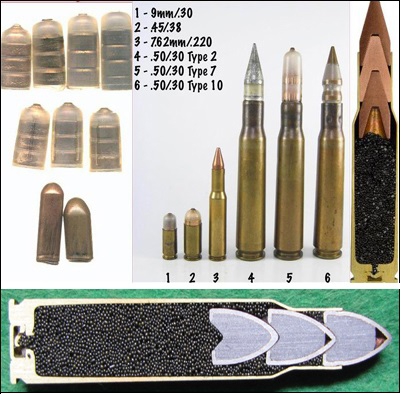
Initially, non-expensive SBB bullets were not widely used because they do not have radical advantages in armor penetration and stopping action before conventional bullets.
In the USSR this topic was dealt with by TsNIITOCHMASH, the duplex cartridges developed there were adopted for service.

The cartridge 12.7x108 / 1СЛ was designed for the Yak-12.7 machine gun mounted on Mi-24D helicopters.
The cartridge is equipped with two armor-piercing-incendiary bullets with a length of 49.4 mm each. Each bullet consists of a bimetallic shell and a steel core in a lead shirt. The core and the jacket are truncated from above, and an incendiary composition is pressed into the gap formed between the core and the shell of the bullet. The first bullet is fastened in the cartridge case with reinforced crimping in a double flute on the bullet. The second bullet is located inside the sleeve, the nose part enters the conical recess of the core of the first bullet, and is additionally fixed by the core of the sleeve at three points.
| Diameter of bullet: |
13.01 mm |
| Cartridge Weight: |
145 g |
| Length of the cartridge: |
145.5-147 mm |
| Effort of bullet extraction from the sleeve: |
250-450 kg |
| Average weight of the bullet: |
31.0 + 31.0 |
| Powder grades: Average weight of the powder charge: |
4/1 фл 15.0 grams |
| Heavy combat of 1st and 2nd bullets R 50 at 300 m: |
? 50 cm |
| Speed of bullet V 25 : |
710-740 m / s |
| Maximum pressure of powder gases: |
3100 kg / cm 2 |
| The GRAU indices: |
9-A-4012 |
The concept of multi-bullet patrons turned out to be tenacious and was repeatedly returned to it. With some of these ammunition, we still encounter.
Arrow-Shaped Cartridges
According to historical sources, arrows were attempted to load smooth-bore guns in the 17th century, and even these hand-made and wooden-loaded charges gave some advantage over the range of fire.
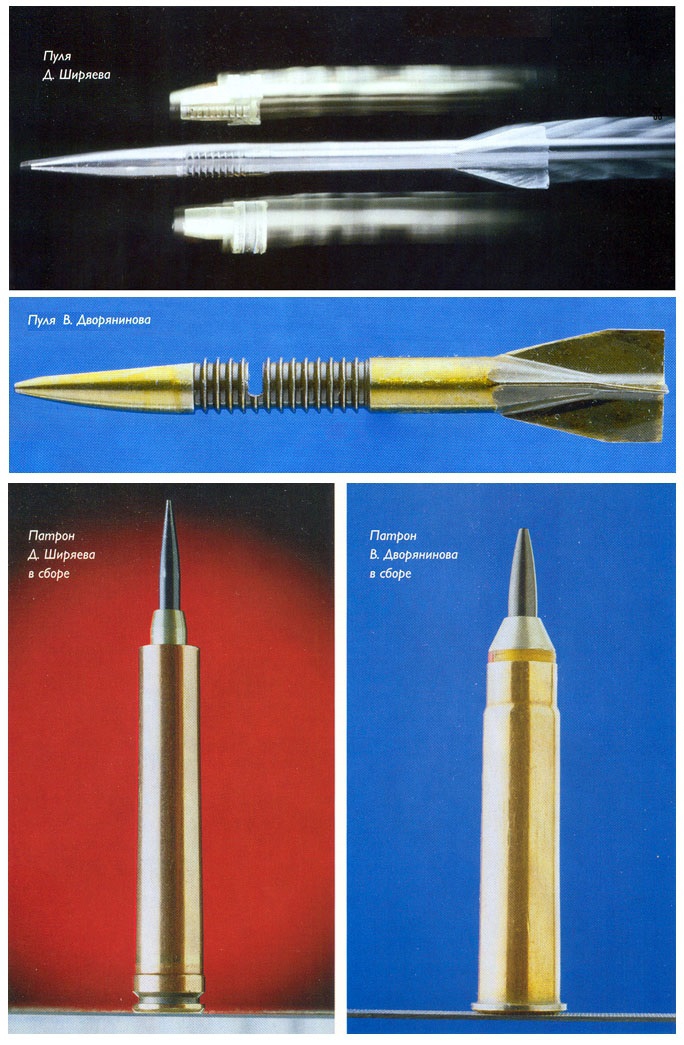
The peak of research in this area occurred in the 60s of the twentieth century. In the USSR, this topic began to be studied at NII-61 (later - TsNIITOCHMASh). The result of the work was a cartridge OPS (feathered sub-caliber rifle) and a submachine gun AO-27.
The OPS (coded designation 18ELC) consisted of a brass sleeve 43.6 mm long with a Berdan system capsule, 50 mm long arrows from grade 50 steel (2.3 g weight, 7.62 mm bullet diameter, 3 mm body diameter), Two-sector pallet weighing 0.2 grams.
The tail empennage of the first shooters was made of plastic, until a relatively inexpensive technology for manufacturing all-metal arrows by punching was developed. The coupling of the elements of the pallet and the bullet was provided by means of ring rolls on the boom body and the inner surface of the driving elements. Management of the sub-caliber bullet along the trunk channel was carried out by a leading type tray with a profile of complex shape.
The tests showed the working capacity of the development, the complete separation of the leading tray from the boom at a range not exceeding 50 meters from the muzzle of the barrel, a high initial speed of the bullet - 1085-1100 meters per second.
According to tests of the "automatic - cartridge with a swept bullet" complex, at the stage of the chief designer its advantage compared to the AK-47 was overwhelming, with the exception of two points - the stopping action and the cost of the cartridge.
According to the stopping action, the feathered bullet to a large extent did not meet the requirements of the military, and this one was enough to leave the topic in the category of R & D, and the cost of the OPS of the cartridge was more than twice as high as the regular one.
As a result, the AO-27 assault rifle and cartridges to it remained in the experimental development stage. The complex with sub-caliber bullets was not adopted.
After that he completed the work on the construction of such ammunition Dvoryaninov VN.
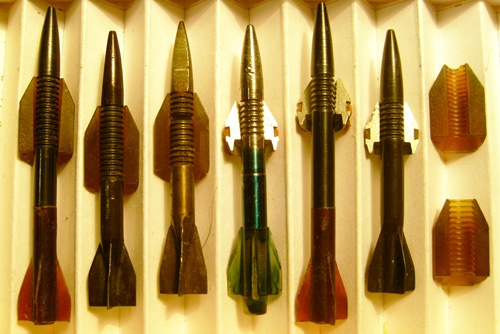
Soon the research work "Foil" (machine gun) and "Finval" (rifle) were opened within the framework of which the Izhevsk machine-building plant developed weapons, and TsNIITOCHMASH ammunition with a sub-caliber arrowed fuser bullet. Specialists of Izhmash developed a sniper rifle based on SVD and a rebuilt SG-43 machine gun. The machine gun and rifle had their own trunks and muzzleheads for breaking the elements of the pallet separating from the bullet.

In the course of development, various versions of cartridges were worked out: experimental double-bullet and three-bullet arrowheads, tracer bullets and bullets with different types of tail fins. According to available data, the production of arrow-shaped bullets was set up at the plant No. 60 in the city of Frunze, and cartridges were equipped using the shells of plant No. 188 (Novosibirsk). The latest known samples date back to the 1980 issue. According to available data in the open press, the final version of the cartridge with a swept sub-caliber bullet had the accuracy of combat comparable to the gross rifle cartridges with a LPS bullet, but significantly exceeded its cost of production. None of the prototypes of weapons and ammunition went into mass production.
Overseas developments in this area have done about the same path. One of the most famous American fired munitions is the .330 Amron Aerojet cartridge (8.38x69 mm) tested under the SPIW program.
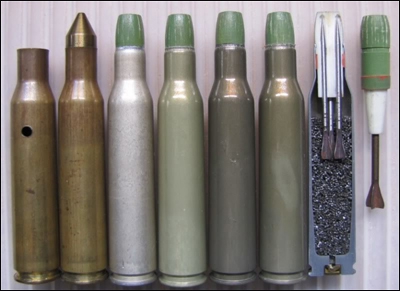
Non-classical assembly cartridges.
Tround cartridge
In August 1958, David Dardik patents "Dardick open chamber gun" - a kind of hybrid pistol and revolver and the so-called tround cartridge.

It was made of aluminum, and then of high-strength plastic, and was originally produced in the calibres .38 (9 mm), .30 (7.62 mm) and .22 (5.56 mm), with the characteristics of the corresponding cartridges 38 SW Special , .32 SW long and .22 LR, the dimensions of the plastic sleeves in all the calibers being identical.
The trumpet cartridges could be re-equipped using standard 5 mm diameter pistol capsules and bullets of the appropriate caliber. The liner had internal annular grooves limiting the fit of the bullet and providing a boost force sufficient to completely burn the gunpowder.
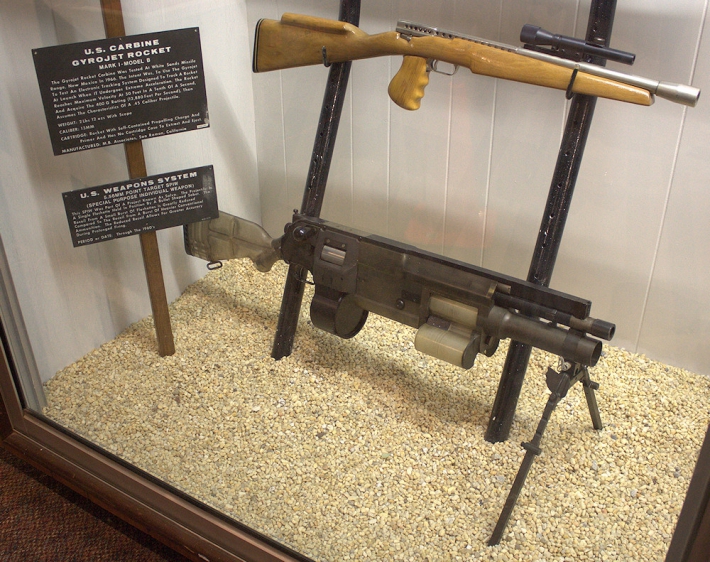
In the top - one of the carbines Gyrojet, at the bottom - a revolver rifle H & R SPIW.
In the course of its development, Dardik's ammunition underwent a lot of modifications, and tround the cartridge (Harrington & Richardson) participated in the list of four main participants of the US program SPIW for developing a promising semi-automatic rifle for a cartridge with a sub-caliber arrowhead bullet.
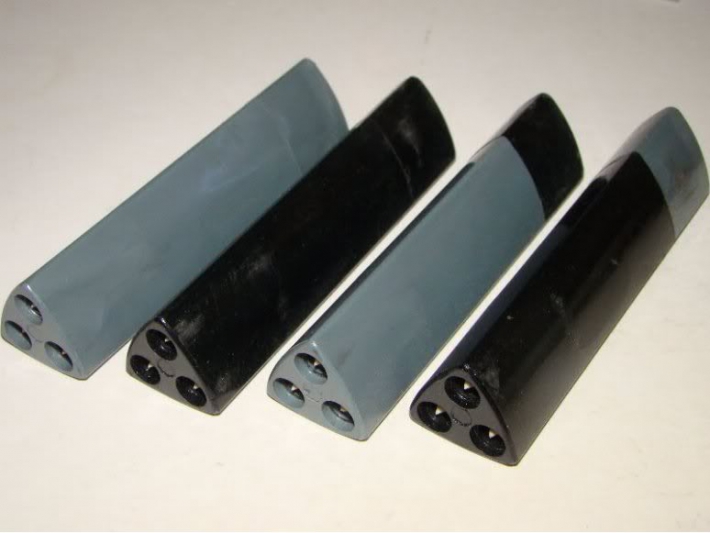
5,56x36 Folded
In 1965, the design engineer of Frankford Arsenal Andrew Grundy patented a cartridge of a very unusual shape. The key element of the new concept was the rejection of the classic form of the cartridge case, replacing it with a plastic capsule containing a powder charge to the side of the bullet.
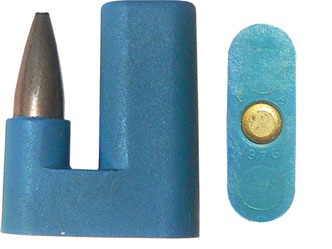
Such unorthodox configuration of the cartridge allowed to reduce its dimensions and realize the scheme of frontal burning of the powder charge, which made it possible to reduce the erosive effect of the powder gases on the barrel bore. Also in theory, the reduction in the length of the cartridge chamber reduces the mileage of the moving parts of the weapon, which makes it possible to realize a higher fire rate at a slower speed of moving parts, to reduce shock loads and mass of weapons.
From 1965 to 1983, U-shaped cartridges were tested in various calibres: 4.32 mm, 5.56 mm, 7.62 mm, 12.7 mm and 30 mm, but they did not find His army or civilian application.
Cartridge AIWS.
In 1970, Mauri Goldin, the designer of the American company Hughes Tool Company, patented the design of a cartridge with a three-chamber sleeve in the form of a parallelepiped and a system of non-locking weapons.
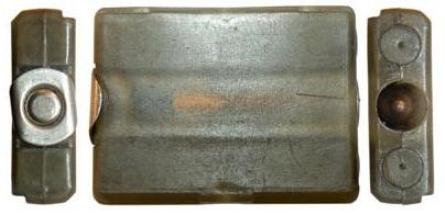
The bullet in the cartridge AIWS is located in the central chamber, and the powder charge is placed in two side chambers. This configuration of the cartridge allowed 54% more ammunition to be stored in a given volume compared to conventional cartridges of the same caliber, and also provided significant savings in mass, which was comparable to the advantages provided by no-kill ammunition. In this case, the plastic sleeve provided the necessary obturation of the powder gases, protection of the propellant charge and the capsule composition from the environment. The rectangular profile of the sleeve allowed to develop a high-capacity magazine and a simple, in comparison with a conventional weapon, a system for feeding cartridges into the chamber and extracting the cartridge case.
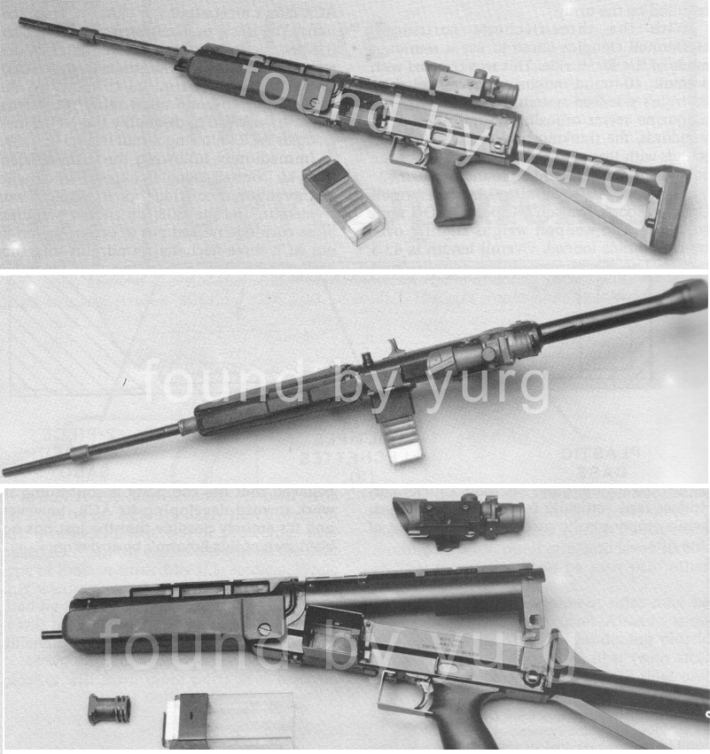
In 1986-88, the McDonnell Douglas Helicopter Company and its arms division HTC contracted with Picatinny Arsenal to participate in the American Advanced Infantry Weapon System program to develop a prospective rifle complex and cartridge for it.
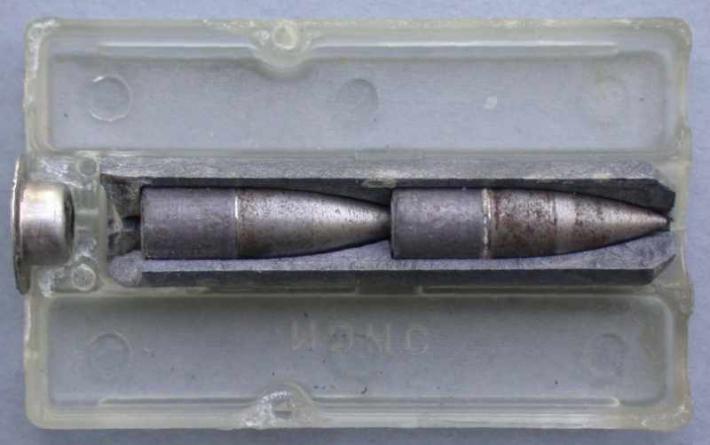
Within the framework of this program, 8,6-mm nominal ammunition ammunition was developed (plastic sleeve containing 2 6.0-mm-caliber bullets), 11.0 mm with five sub-calibrated bladed arrowheads and 9.0 mm with three sub-calibrated feathers Bullets. But the assault rifle did not pass the competitive selection, and the development of ammunition was stopped.
5,56x30 AIWS
| Diameter of bullet: |
5.7 mm |
| Length of sleeve: |
30.77 mm |
| Width of sleeve: |
23.11 mm |
| Thickness of sleeve: |
7.6 mm |
| Bullet weight: |
4.43 g |
| Cartridge Weight: |
9.71 g |
| Starting speed: |
850 m / s |
Perforated cartridges
Comp Bullet
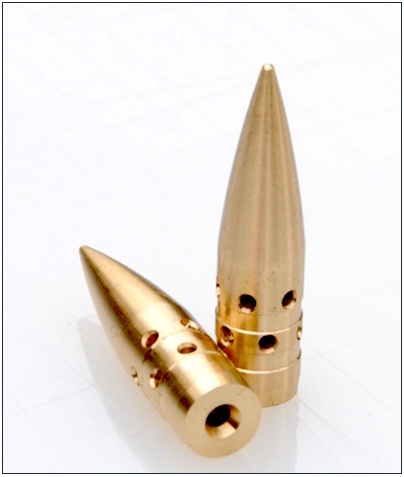
In this pool, with the aid of high-precision machines, several holes communicating among themselves are made.
When shooting a Comp bullet, the powder gases pass through the holes in the walls of the bullet and reduce friction about the barrel cuts. According to the assurances of the developers, the holes also play the role of a kind of muzzle brake and reduce the impact of the shot.
7х56 Broadway Trust with perforated sleeve.

In 1941, Sir Dennis Burney, offered the UK supply minister a project to develop portable recoilless anti-tank rifles. With the support of the state, the joint company Broad Trust Company (BTC) was founded.
Initially, developments were carried out in the field of designing ammunition with a caliber within the range of 20-88 mm. The use of "holey" cartridges should reduce the impact of the shot to the values that allow shooting from the hands and develop a sufficiently powerful and light anti-tank gun. Gradually, the focus of developments shifted to designing guns of smaller caliber.
After a series of unsuccessful development of large-caliber recoilless rifles, in 1942 work was begun on designing a small-caliber rifle for a 6.35-mm cartridge, but, faced with the problematic of creating an effective tracer, the caliber of the cartridge was increased to 7 mm.
The cartridge of 7-mm caliber had a composite (of two parts) brass bottle-shaped sleeve (the version of the cartridge was worked out and with a full perforated sleeve). Several rows of through holes were drilled in the upper part of the sleeve. The upper part of the sleeve was screwed into the lower part, in which a groove was made to form a rim for gripping the sleeve with an extractor. In the chamber of the gun, the lower part of the cartridge case was located in its narrow part and at the time of the shot it expanded, providing for the obturation of the powder gases, and most of the powder gases were poured through the holes in the walls of the upper part of the cartridge case into the cavity of the chamber of increased volume. This allowed to relieve the excess pressure, which provided a significant reduction in the recoil momentum during the shot.
The cartridge was equipped with a powder charge of NRN 150 with a mass of 9.72 grams, which allowed developing a starting velocity of 783 m / s to the bullet. The powder charge consisted of white spherical pellets and was loaded into the sleeve in a bag of cellophane. Development and testing continued until March 1948, when it was decided to stop financing the project, followed by the closure of BTC.
| Diameter of bullet: | 7.02 mm |
| Length of the cartridge: | 76.86 mm |
| Diameter of the cartridge case: | 7.94 mm |
| Length of sleeve: | 56.0 mm |
| Diameter of the shell edge: | 15.65 mm |
| Bullet weight: | 10.82 g |
| Cartridge Weight: | 19.94 g |
| Starting speed: | 783 m / s |
Silent cartridges
7,62х63 Snake
7,62х63 Snake - one of the special cartridges for noiselessly-flameless shooting with the cutoff of powder gases.
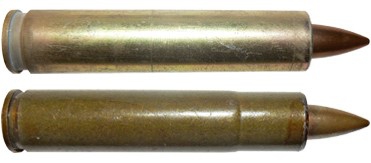
In the 1950s, the NII-61 was commissioned by the USSR KGB to begin creating a special silent double-shot pistol and cartridges to it. The complex consisted of a special pistol C4 and a silent cartridge PZ (cartridge "Snake").
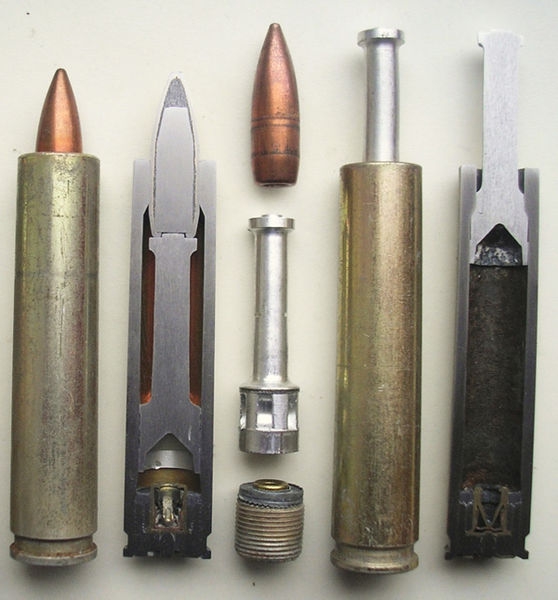
The cartridge of 7.62 mm PZ consists of a steel sleeve with a small taper, inside of which there are: a KVM-3 primer-igniter in a hub with a movable drummer (screwed into the bottom of the sleeve and providing powdered gases from the capsule), powder charge of grade P -125 and the pushrod piston. The cartridge is equipped with a bullet caliber 7.62-mm PS.
When shot, the mobile drummer of the cartridge produces a piercing of the capsule, which ignites the powder charge. The pressure of the powder gases drives the piston, which pushes the bullet into the bore of the barrel, giving it an initial speed of flight equal to 170 m / s. When the extreme upper position is reached, the piston rests against the narrowing of the walls of the liner and stops, ensuring that the powder gases inside the liner are blocked and the shot is noiseless. The length of the cartridge case with the piston leaving it is 82.3 mm.
Training and training cartridges
Wooden cartridge 6.5 x55 mm Mauser. Of course, it can not hit the target - the bullet completely collapses when you exit the barrel of the gun barrel.
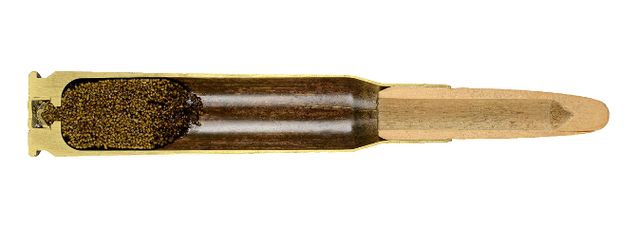
Modern training cartridges are often made of plastic.
Training cartridge L14A1 caliber 7,62х54 mm with tracer bullet. In this cartridge only the bottom of the cartridge case and the internal element of the bullet are made of metal.

Plastic cartridges are used by military men for exercises, in the civilian market they are also in demand - for entertaining shooting. They are equipped with a small charge of gunpowder, which makes the shooting relatively safe.
The only significant drawback of these munitions is that most self-loading rifles and pistols will have to send the next cartridge manually - the automation is unreliable because of the reduced amount of powder and small mass of the bullet.
G2R RIP - new expansive
By itself, expansive bullets are not so unusual, but the latest development of G2 Research definitely deserved its place in this material.

According to press releases, the small teeth of this bullet in flight create a turbulent flow, help stabilize the bullet and make it more accurate, and when hit like a circular saw cut through clothes, glass, gypsum board and even sheet metal, allowing the bullet bottom to confidently hit the target.
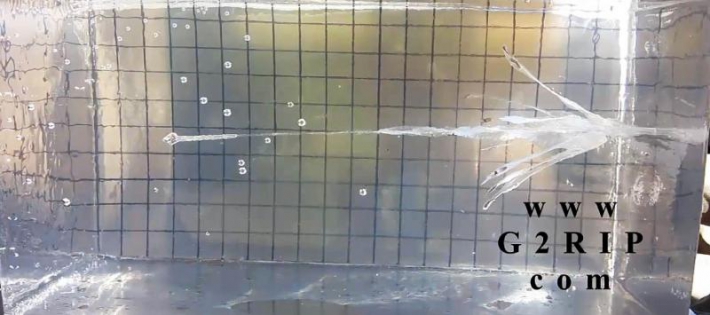
G2R RIP - lead-free, all-copper bullet, weighing 96 grids, is divided into 9 trihedral prongs. The initial speed of the bullet is 386 m / s. The muzzle energy is 660 Joules.
The company G2 Research in the near future expects to begin production of cartridges .380 ACP, .357 SIG, .40, .45ACP, as well as rifle cartridges equipped with such a bullet.
The cost of such cartridges is reportedly to be about 2 dollars apiece. In addition to the high cost, the shortcomings of this ammunition include the potential for premature opening of the teeth.
Managed bullet
The product of Sandia National Laboratories, demonstrated to the general public in November 2011.
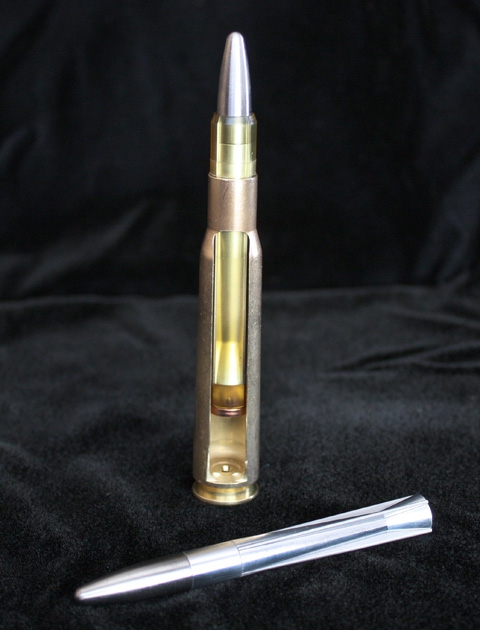
At the tip of the bullet is a tiny optical sensor that detects a laser beam that illuminates a distant target. The microcomputer processes the signal from the sensor and deflects the miniature stabilizer planes, changing the flight path. The bullet is able to independently correct the flight 30 times per second during the entire flight time at a speed of more than 600 m / s. In flight, the bullet is stabilized not by rotation, but by aerodynamic planes, which allows you to more accurately orient the optical sensor and control the flight.
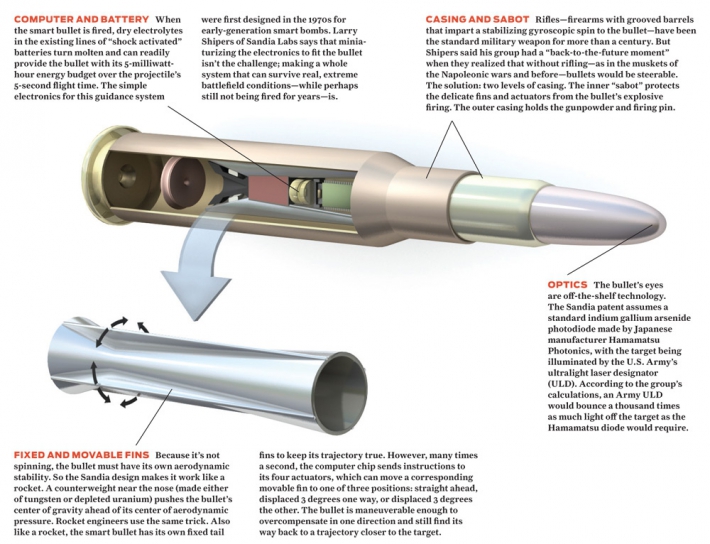
Experimental pistol .45 caliber
Experimental pistol .45 caliber, Czechoslovakia, 1960-70. It seems to be not a fake.
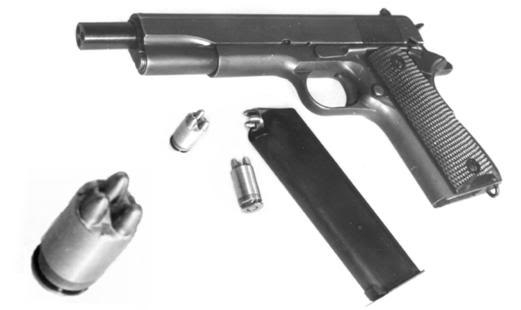
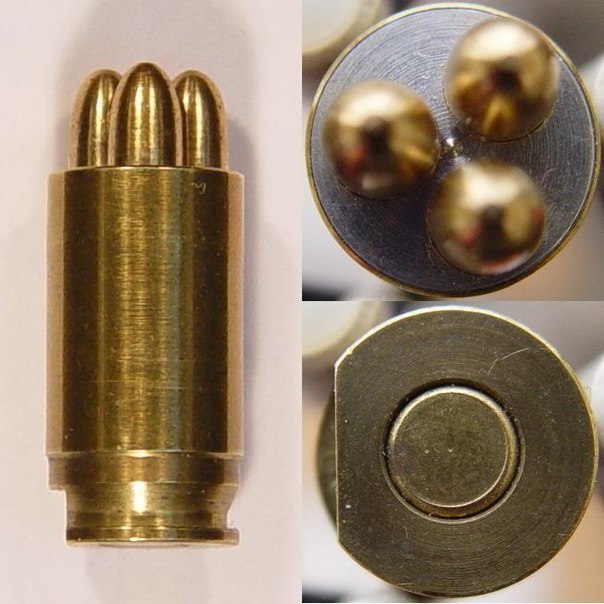
96 grains = 6.22069536 grams
"In the United States and Great Britain, the grana is still used in certain areas, for example, in military matters (mainly in the field of small arms) to measure the weight of bullets and powder charges."


Comments
When commenting on, remember that the content and tone of your message can hurt the feelings of real people, show respect and tolerance to your interlocutors even if you do not share their opinion, your behavior in the conditions of freedom of expression and anonymity provided by the Internet, changes Not only virtual, but also the real world. All comments are hidden from the index, spam is controlled.